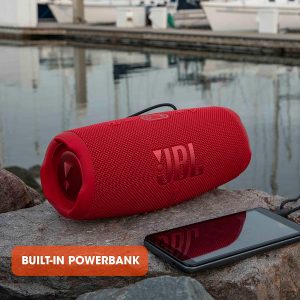We all know that feeling—you’ve got a perfectly fine speaker, but the new version comes out, and suddenly, your old reliable starts looking a bit… aged. That’s the exact situation with the JBL Charge 5 and the JBL Charge 4. On paper, it might seem like JBL just made a few tweaks. But once you dive in, things aren’t so simple. Are the changes in the Charge 5 enough to ditch the Charge 4? Or are we just looking at a mildly updated shell on the same beast?
We took both speakers for a spin, tested them in real-life scenarios, and got a clear idea of what’s changed—and what hasn’t. If you’re stuck between saving a few bucks on the Charge 4 or going all-in with the Charge 5, keep reading.
Practically the same body, but a different face

At first glance, you’d be forgiven for thinking nothing’s changed. The Charge 5 and Charge 4 are almost identical in size and weight—both come in at about 22 cm long and just under a kilo. On the shelf, you’d have to look twice to spot the differences.
That said, the Charge 5 looks cleaner, sleeker—more modern. The old red JBL logo on the Charge 4 has been replaced with a big, bold monochrome logo that spans the front. You either love it or you don’t. And then there’s the battery indicator: the Charge 4 uses five dots, while the Charge 5 switches to a thin horizontal bar. Is it a big deal? No. But it adds to the minimal redesign JBL’s clearly aiming for.
Now, here’s a change that does matter: the Charge 4 comes with a 3.5 mm AUX input, while the Charge 5 doesn’t. That’s right—if you like plugging in a cable and skipping Bluetooth altogether, the newer model isn’t for you. This signals a shift: JBL’s moving toward a wireless-only experience. Not everyone’s going to be thrilled about that.
Sound performance: the tweeter makes its entrance
This is where the Charge 5 starts to earn its number. While the Charge 4 pushes out 30W through a single full-range driver, the Charge 5 steps things up with a 30W woofer plus a 10W dedicated tweeter. That extra driver gives the highs a much-needed lift.
Vocals are crisper, highs feel cleaner, and there’s more separation between the bass and treble. It’s not a night-and-day difference, but once you hear it, you don’t really want to go back. Bass response on both is strong, helped by those dual passive radiators, but the Charge 5 delivers more detail overall.
That said, distortion creeps in at high volumes on both, especially if you push them past 85%. And while the Charge 5 can technically get louder, the improvement in volume isn’t huge—it’s the quality that makes the biggest leap.
Both speakers share a frequency range of 60 Hz – 20 kHz, so the overall depth of sound doesn’t shift dramatically. But if you want something that feels a bit more polished, the Charge 5 brings a noticeable edge.
Battery life: same longevity, same charging time

This one’s simple: no change here. Both speakers are rated for up to 20 hours of playback, though in real-world use, you’re likely getting closer to 11 to 13 hours, depending on how loud you play them.
Charging time? Also the same. Roughly 4 hours through USB-C. No fast charging, no new tricks—just the same solid battery life that JBL’s Charge series is known for.
Both models double as PowerBanks, meaning you can charge your phone or another device through the USB-A port. That’s one of the Charge series’ best perks, and JBL wisely kept it.
Durability: from splashproof to sandproof
Here’s where the Charge 5 quietly but significantly outshines its older sibling. The Charge 4 is IPX7-rated, which means it can survive a dunk in water, but offers no protection against dust.
The Charge 5, on the other hand, comes with IP67 certification. That adds dustproofing to the waterproof rating—a big win for anyone who takes their speaker to the beach, trail, or anywhere sand and grit might sneak in.
If you’re the type to toss your speaker into a backpack or leave it out at a campfire, that extra protection might be the deal-sealer. The Charge 4 is still solid, but the Charge 5 is built for rougher environments.
Wireless upgrades—but a compatibility catch
Now we get to Bluetooth—and this is where we hit a bit of a sore spot.
The Charge 4 uses Bluetooth 4.2, while the Charge 5 jumps to Bluetooth 5.1. That means better range, faster pairing, and a more stable connection overall. In day-to-day use, it just works a little smoother. Pairing feels quicker. Drops are less likely.
But… here’s the catch. The Charge 4 uses JBL Connect Plus, while the Charge 5 uses JBL PartyBoost. And no, they’re not compatible. So you can’t link a Charge 4 and a Charge 5 together—you have to stay within the same generation of connectivity.
If you’ve already got older JBL speakers that use Connect Plus, the Charge 4 plays nice with them. But if you’re starting fresh or already have a PartyBoost-enabled model like the Flip 6, the Charge 5 fits right in. Just know: there’s no mixing across these protocols.
Extras? Not much to report

JBL keeps things minimal with both models. No microphones, no voice assistants, no speakerphone capabilities. These are pure music machines. And honestly, we respect that. You’re not buying a Charge speaker to have a chat with Alexa.
Both speakers are supported by the JBL Portable app, which lets you check battery levels, install firmware updates, and link speakers for stereo or PartyBoost. But there’s no exclusive software magic on either side. If you’re expecting app-only features, you won’t find them here.
So… which one makes more sense?
We’ve used both. We’ve sat with both on balconies, in living rooms, at beaches. And here’s what it boils down to:
The Charge 5 refines the Charge 4—it doesn’t reinvent it.
The addition of a tweeter makes the Charge 5’s audio more nuanced, the dustproofing adds peace of mind, and Bluetooth 5.1 gives it a more future-proof connection. It’s the smarter pick if you’re starting from zero or want to get the best JBL has to offer in this range.
But the Charge 4 still has value, especially if you want wired playback via AUX, or if you already own other JBL Connect Plus speakers. And since they’re nearly identical in battery life and core functionality, you’re not missing much by sticking with the older model.
If budget matters more than future-proofing, the Charge 4 is still a beast. But if you’re ready to move forward with better clarity, better connectivity, and better durability, the Charge 5 earns its “next-gen” label—quietly, confidently, and without forcing it.
Sometimes, subtle wins are the best kind.


